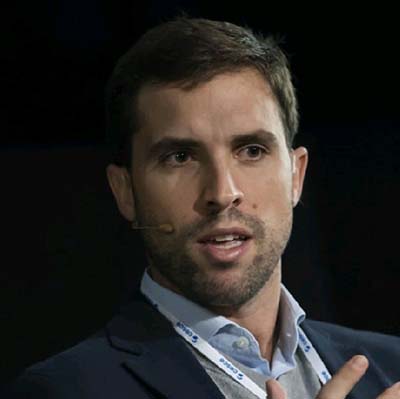

- Carlos Serrano García-Lisón
- Co-CEO and Co-Founder, Embat

- Tom Alford
- Deputy Editor, Treasury Management International
Embat’s Automation Platform Delivers Treasury Gold
Named after the fresh Mallorcan thermal breeze, Embat wants to offer treasurers a new way to experience technology. Carlos Serrano García-Lisón, Co-CEO and Co-Founder, of TMI Innovation Lab entrant Embat explains how.
Embat is a real-time treasury automation platform. It is currently aimed at medium to large corporates, where complex legal structures, and a multi-country presence with many different banking relationships tend to make the life of the treasurer somewhat more challenging than necessary.
By providing a centralised platform for banking connectivity, treasury processes, payment automation and automated accounting and reconciliation, the data and information flows within these corporate ecosystems can be managed from a single, fully cloud-native entry point.
Related Content
Opportunity knocks
To this end, Embat became an operational platform at the close of 2021. It is the culmination of considerable time and effort, not least on product research and development, by its co-founders, former J.P. Morgan executives Carlos Serrano García-Lisón and Antonio Berga. Both had specialised in investment banking, with Berga serving the needs of corporate clients, while Serrano García-Lisón moved towards private equity firms and the day-to-day finance operations of their portfolio companies.
Following the regulatory disruption that was PSD2 and open banking, the partners saw an opportunity. This would eventually take them from the relative security of a global banking giant, and drop them into the exciting world of the fintech startup. Their plan was founded on the observation that while corporate treasurers had a clear need for quick answers to their everyday operational questions, the software platforms available to them were often too big and complicated to meet that requirement.
While Serrano García-Lisón had trained in industrial electrical engineering before entering banking, he admits to “not knowing how to write a single line of code”. This, he adds, “was definitely an issue”. But four months into the project, it was solved with the arrival into the nascent business of a third partner, Tomás Gil. Assuming the role of CTO, Gil brought a great depth of technical knowledge and understanding, having served as CTO at Fintonic, a Spanish consumer fintech with a sizeable presence in Latin America.
“We were extremely lucky to get him on board,” comments Serrano García-Lisón. “Obviously he is a key pillar for the project. So now the three of us are driving and leading the whole company.”
Straight to the (key) points
The Embat platform today has users in Spain, the UK and Germany. These are serviced by circa 90 employees, most of whom are located in Spain, with ‘market-ready’ teams in the UK and Germany, and more planned. As the majority of its client roster operate internationally from these locations, the platform’s reach extends into at least 60 countries, with a portfolio of 50 banks and rising already integrated via Embat’s library of open and proprietary APIs.
So how has Embat managed to grow at such an impressive pace? By bringing consumer platform sensibilities to the core needs of today’s corporate treasurer, Serrano García-Lisón believes it makes for “a very easy user experience”. But allied with Gil’s extensive API banking connectivity experience – Fintonic was a pioneer in the Spanish consumer market for API and real-time connectivity with banks – the platform is also founded on the partners’ deep corporate and banking knowledge.
In “a story that speaks to how customer-centric we are”, Serrano García-Lisón explains how this focus has informed the development approach to the platform from the outset. Embat’s initial interest, he says, was how international groups, with many different legal entities, “often struggled with something as theoretically simple as consolidated real-time cash monitoring”.
With decentralised finance teams, and not all banks offering the technological means required by companies to achieve this view, the advent of Covid exposed just how challenging this was.
During the peak of that period, while Serrano García-Lisón was still working with a range of private equity client portfolio companies, he saw how daily cash monitoring had become part of their essential survival mechanism. “But it was extremely difficult for their treasurers to obtain a consolidated cash position. It’s a simple data point, but many were forced to log into multiple banking platforms, and often speak directly with colleagues in different countries, to try to acquire the data. Then they had to consolidate that in an Excel file before reporting up to the CFO.” When time was often limited, that was an unmitigated risk factor.
Serrano García-Lisón already knew that APIs could be used to connect corporate bank accounts, to serve up a “single source of truth”. Having grasped the full extent of the cash-consolidation issue, it then became something of a mission for him to explore how else finance teams could be better served by technology, automating basic but nonetheless vital manual day-to-day tasks.
“We continued to listen to customers and discovered that manual cash forecasting was also absorbing too much of their time. We knew that would be the next automation piece. Soon after we added integration of accounting systems.”
As the conversations continued, Serrano García-Lisón learned how burdensome bank reconciliations and bank statement booking into ERPs really were. “Then we started talking about payments. Treasurers were asking how, with different banks around the world, they could centralise payment processes and control components such as AML, compliance and anti-fraud, and payments reconciliations.”
Feeling the need for speed
It was agreed that the evolution of Embat’s platform would continue to respond to real-world needs, with client discussions informing the build-out of new solutions and use cases for automating the treasury workload.
What was also clear at an early stage was the initial target market. While large-cap corporates and MNCs typically view a TMS as a ‘must-have’, there are many more mid-caps around the world where the same challenges exist, yet the available solutions are often perceived as being “implementation heavy”, in terms of cost and the time and effort required to go live.
Serrano García-Lisón’s conversations revealed that the ROI on established vendor systems “was sometimes felt to be not there, or simply not good enough for these companies to justify their deployment”. Of course, for any market aspirant, this had to be resolved. And based on the requirements of a typical implementation, he claims Embat project times are now “on average around four or five times faster than our competitors”.
It’s quite a claim, but one he says is delivered courtesy of how Embat chose to format its technology. “It’s about efficient connectivity, both with the clients’ accounting systems, and with the banks themselves,” he explains. “It’s one of the key benefits of APIs versus file-based information transfer.” Indeed, when real-time information is important, he declares APIs “unmatched”. But he also explains that the platform is “agnostic”, with provision for alternative data transfer methods, “when they are the best option”.
For implementations, executing a fully digital project enables certifications and authentications for third-party connections, for example, to be managed online. “That accelerates an average project time of eight to 12 weeks, to a matter of minutes. In practice, that means a customer requesting full API connectivity will, on the first day of implementation, already have access to real-time cash positions. That can make the ROI more attractive for finance teams.”
Typically when not using API connectivity, a one-to-one technical per client ‘handshake’ with a bank is required. APIs enable one-to-many, explains Serrano García-Lisón. An agreement with the bank is made upfront regarding how the information is going to be shared, the encryption used, and the technological certificates applied.
“Once all of this is agreed, it’s just a matter of authenticating the user and making sure that authentication is valid. The channel itself is already built for one-to-many and that is what actually makes it much more efficient.”
When business is a breeze
With Berga from Mallorca, and Serrano García-Lisón born and raised in Gran Canaria, their island roots found representation in Embat. Embat, as mentioned in the introduction, is a thermal wind that blows off the Balearic island of Mallorca, Spain.
This meteorological phenomenon is driven onshore, as a light breeze, throughout the day by the heat differential between the heating landmass and the cooler sea. Later, as the sea heats up, the wind heads back offshore, creating a continuous cycle throughout the summer months.
Cutting through the noise, hearing the customer
To ensure it could build the appropriate infrastructure, Embat needed to find the right mix between proprietary API technology and third-party tools. This would give it the flexibility and resiliency to cover many different customer needs around the world.
While he feels that the mix of API connectors and Embat’s logic engine represent “probably the most valuable piece of all of our software”, this set-up combines with a front end that has been designed to a large extent by its users. This generates “one of the best user experiences”.
Co-creation is clearly an important part of the Embat development model. “We have ideas, but we bounce these off our clients. They are very involved in the creation phase. And I think the end result of user involvement is building products and experiences that resonate with the way they work, which is ultimately what every user looks for when they interact with software.”
As clients are onboarded, each brings a new perspective, and the co-creation process continues to deliver. This can happen at an early stage in the relationship too, highlights Serrano García-Lisón. “Our product design team probably spends up to 50% of its time speaking to our existing and new users. But sometimes when we are in the process of pitching a solution, and we receive feedback about a specific function, we will have a product designer join the call, offering their perspective on how to help that client.”
Building credibility with the customer is an important part of the client relationship. It helps them to see first-hand that they are being listened to, but obviously not every wish can be granted. “We need internal discipline to filter all of those client suggestions, sifting the ones we think are scalable for many customers from those which are just too niche,” admits Serrano García-Lisón. “But we are determined that our users are the ones who define where our platform goes, and tell us where we can improve. It’s our job, after identifying those challenges, to find the best solutions for them to continue using our platform for an increasing range of activities.”
Reducing the steep learning curve for new users of treasury platforms is, he says, a guiding thought for Embat. Even with legacy or more traditional software, there comes a point in a platform’s development cycle where, as new features and functionalities emerge, it becomes “almost unmanageable”. The aim for Embat, he says, is to work out how to curate the best experience for users, enabling impactful customisations and changes but avoiding “too much noise with all of the interfaces”.
As part of that approach, partnerships evolve. Embat’s core functionalities and features are mostly in-house built, to ensure the company is in full control as far as possible. However, Serrano García-Lisón says non-core aspects, or those that the team believes can be better executed externally, will see it work with partners. “It’s not a case of who builds it, but how well it solves the client’s problem. If that means we integrate with another system or bring in a partner, that is the right approach because, in the end, what matters is the customer.”
Attracting the money
Funding the development of a new treasury solution is a challenge; fintech is an extremely busy market, and attracting the right investment partners and funding levels is of existential importance. The three co-founders had decided at an early stage that they wanted to build a global solution, so the pressure was on immediately.
“We came from global corporates and wanted to replicate that experience,” explains Serrano García-Lisón. “We also knew that our target customer would be medium-to-large businesses because they often operate in multiple jurisdictions. But building a global platform is expensive – and the tech world evolves quickly – so we had to make sure we were on top of the latest trends, and that requires significant capital.”
Serrano García-Lisón admits that securing the first investor was a challenge. “Obviously our backgrounds helped. But nevertheless, the first is always a hard sell because while you have a story, a mission, and a vision, you have no evidence.”
It helped that the nascent Embat could ‘bootstrap’ for almost a year (using the co-founders’ own money). “We were conscious that we didn’t want to bring in external funding until we internally believed we had a product and a market,” he explains. It soon became apparent that Embat had both.
Finding the financial partners to kick off the official project, and then shape the offering according to the team’s goals, has so far seen three financing rounds. All have been with institutional investors. “In three years, we’ve raised €21m. It’s testament to our ambition, but it’s also a testament to our investors’ commitment to our story. They believe we have a role to play in building a global software platform to help finance teams streamline their treasury operations.”
Snowballing towards the billion-euro businesses
The first customers arrived soon after launch, reports Serrano García-Lisón. “They always come through people you know, or people that have been following your story. They are the initial believers that, while the product is still not quite there, these guys can probably build something that makes sense.”
Further confirming the team’s belief that its solution has mileage has been its “snowballing” growth pattern. The more businesses that become clients, the more it opens up the market for others to come on board, Serrano García-Lisón notes. With the company now able to scale up, he is nonetheless a little surprised that Embat is already servicing multibillion-euro companies, commenting “it happened much earlier than we initially thought it might”.
Expansion of the client base into the MNC sector will require more investment, as indeed will continual development of the platform to meet the spectrum of functional and integration needs for these players. It’s not a target market yet, says Serrano García-Lisón, but he is starting to see more cases where the largest companies are realising they do not necessarily need an infinitely customisable solution, and consider the offerings of youthful firms such as Embat to be “something they could live with”.
The customer base to date features several traditional businesses. But it is also capturing the attention of a number of tech businesses with international scope. In Germany, for example, it is working with the publicly listed data centre and cloud provider Northern Data, which has offices in Germany, the UK, Ireland, the Netherlands, Norway, Sweden, and the US. And Embat client Cabify is gaining momentum as an Uber competitor in Spain and Latin America. Other users have a presence in Asia and the Middle East.
The rapid growth of businesses such as these tests Embat’s scalability. Serrano García-Lisón is drawn to note that it has proven to be capable of “fitting and configuring very well within their increasingly complex processes”.
Global product, global presence, but nothing gung-ho
With this in mind, Embat’s commercial ambitions continue apace. Offices in the UK and in Germany were opened in 2024, complementing the existing Spanish headquarters. Other European countries, and beyond, are already earmarked. “We are seeing traction in new markets, and that gives us comfort as we begin our expansion plans,” notes Serrano García-Lisón.
“In the beginning, we were trying to be a bit more gradual with international growth, but we know now that our product works in Spain and in other markets. Today, we truly believe that the only way to properly serve our customers is by building a global product and having a global presence.”
Embat will nonetheless be guided by its own understanding of where the platform differentiates itself from other solutions; it will compete based on realism not gung-ho ambition. It also knows that the impetus to expand will continue only if the platform maintains its trajectory of technical maturity and strength.
Indeed, as “the most important pillar”, more than 60% of Embat’s employees are today focused on R&D. “We will continue to leverage existing and new technology to make this process more efficient and, most importantly, we will continue to listen to clients,” comments Serrano García-Lisón.
One step beyond
“It’s been a good experience throughout,” comments Serrano García-Lisón on the process of bringing Embat to life. “There’s probably a few things I would change if we did it again – giving the development cycles more space, for example – but, obviously, we can’t fail to be happy with where we are right now.”
But there is no doubt in his mind that the team assembled to bring Embat into being has played a major part in its success to date. “We’ve been extremely lucky,” he states. “The whole team shares the same passion, ambition and values. It’s a team that has made all of us better. The time has long gone when this was an Antonio, Tomás and Carlos project. It’s now a 90-person business.”
While he looks back on his mainstream banking career with much fondness – “I would 200% recommend that path to anyone” – Serrano García-Lisón professes that he “loves this much more”.
Indeed, Embat moves him “a step further”. The level of involvement and commitment here is different, he adds. “And being able to shape the vision and culture of your own business is something that is unmatched.”



